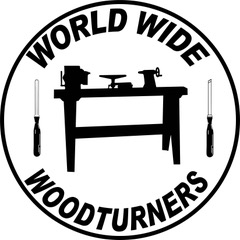… Continued from April 23, 2025
Engraving Non-Wood Materials: Expanding Your Creative Possibilities
While wood is the most common material for laser engraving in woodturning, many other materials can be engraved with stunning results. Exploring acrylic, leather, metals, glass, and stone opens up a wide range of new design possibilities, from personalized keepsakes to artistic embellishments. However, each material behaves differently under a laser and requires specific settings, preparation, and safety considerations to ensure the best outcome.
This section covers popular non-wood materials that work well for engraving, how to prepare them forthe best results, and key considerations when working with each type.
Acrylic – Crisp, Frosted Engravings
Acrylic is one of the best non-wood materials for laser engraving, especially when creating designs that require clear, detailed contrast. When engraved, acrylic produces a frosted, etched effect, making it perfect for signs, plaques, display pieces, and decorative inlays for wood turned objects.
Best Acrylic for Engraving: Use cast acrylic (not extruded acrylic) for the cleanest engraving results.
Avoid extruded acrylic, as it does not engrave well and can create inconsistent finishes.
Pro Tips for Engraving Acrylic:
- Use low power and high speed to prevent melting or warping.
- Engrave on the back side of clear acrylic for a smooth, polished look when viewed from the front.
- Clean acrylic after engraving with a mild soap solution and a microfiber cloth to remove residue.
Leather – A Rich, Textured Finish
Natural leather engraves beautifully, creating bold, dark markings that add character and texture to wallets, keychains, belts, and book covers. However, not all leather is safe for laser engraving—some types contain chemical treatments that release harmful fumes when burned.
- Best Leather for Engraving: Vegetable-tanned leather provides the best engraving results and is safe to use.
- Avoid chrome-tanned leather, as it contains chromium salts, which produce toxic fumes when burned.
Pro Tips for Engraving Leather:
- Use moderate power settings to prevent overburning or excessive charring.
- Engrave on lighter-colored leather for greater contrast.
- If the leather feels dry after engraving, apply a light leather conditioner to restore suppleness.
Glass & Stone – Etching for a Frosted Look
Laser engraving on glass and stone creates a frosted, sandblasted appearance without cutting into the surface. This technique works well for engraving on wine glasses, tumblers, coasters, and stone plaques.
Best Glass & Stone for Engraving: Tempered and borosilicate glass (e.g., Pyrex) are commonly used for engraving.
Avoid engraving highly polished glass, as it can lead to uneven engraving or chipping.
Pro Tips for Engraving Glass & Stone:
Apply a thin layer of dish soap or masking tape before engraving to prevent small fractures.
- Use low power and high speed to reduce stress on the material.
- Clean the engraving with a soft brush or compressed air to remove fine dust particles.
Anodized Aluminum & Coated Metals – Precise Marking
Laser engraving on anodized aluminum and coated metals allows for sharp, detailed markings without damaging the underlying metal. These materials are commonly used for custom nameplates, branding on metal inlays, and engraved hardware in woodturning projects.
Best Metal for Engraving: Anodized aluminum, stainless steel with marking spray, and coated brass work well.
Avoid engraving raw aluminum or bare steel unless using a fiber laser, as CO2 lasers do not effectively engrave uncoated metals.
Pro Tips for Engraving Metal:
- Use a marking spray (like Cermark or Thermark) when engraving uncoated metals to achieve dark, high-contrast results.
- Adjust laser settings to lower power and higher speed to avoid overheating the metal.
- Wipe the surface clean with isopropyl alcohol after engraving to remove any residue.
Fabric & Textiles – Soft but Detailed Engraving
Laser engraving on fabric and textiles allows for intricate patterns, monograms, and designs on materials like denim, canvas, felt, and suede. This technique is popular for custom apparel, decorative bags, and textile-based art projects.
Best Fabrics for Engraving: Cotton, felt, microfiber, and denim work well with laser engraving.
Avoid synthetic fabrics like polyester, nylon, and PVC-based vinyl, as they can melt or release toxic fumes.
Pro Tips for Engraving Fabric:
- Use low power settings to prevent burning through the fabric.
- Test a small area before engraving to see how the fabric reacts.
- Apply masking tape over the engraving area to reduce scorching.
Final Thoughts on Engraving Non-Wood Materials
Exploring non-wood materials expands the creative potential of laser engraving, allowing for versatile designs on a variety of surfaces. Whether engraving glassware, leather accessories, acrylic inlays, or metal branding plates, understanding the best materials and proper settings ensures clean, precise, and professional results.
When working with non-wood materials:
- Always check the safety of the material before engraving—some materials release toxic fumes.
- Test settings on a scrap piece to find the best speed and power combination.
- Use proper ventilation to remove fine particulates and smoke from the engraving process.
With the right approach, engraving non-wood materials can add a whole new dimension to woodturning projects, making them even more unique and valuable.
To be continued in May 21, 2025 …
